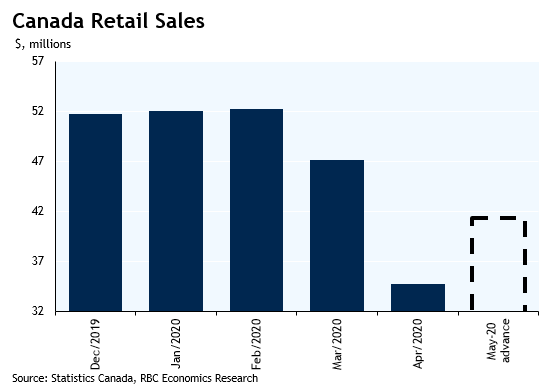- April retail sales plunged 26% – much softer than the -15.6% preliminary estimate a month ago
- Sales down across the board – except for a surge in online sales
- Preliminary estimate that May sales increased 19%
The drop in April retail sales in Canada was massive – and significantly larger than the 15.6% drop Statistics Canada provided as a preliminary estimate along with the March report. Controlling for price changes, sale volumes were down 25% from March in April and down almost a third compared to “pre-shock” February levels. April sales were down in virtually all sub-categories, except online sales (not all of which are included in the headline retail sales count) which were up a whopping 120% compared to a year ago in April and 56% from March. The level of grocery store sales was also still 13% above February levels despite a 13% drop in April.
Virtually all economic data for April has been exceptionally soft – manufacturing and wholesale sales reported earlier in the week were both also down more than 20% in April. Statistics Canada already provided an advance estimate that overall GDP declined 11% in the month, but reports to-date have left risks tilted to the downside of that.
But it is also increasingly clear that the massive decline in economy-wide output ended at two-months in April – and that is still taking some of the sting out of exceptionally ugly backward-looking economic data. Statistics Canada’s preliminary count of May retail sales showed an increase of 19%. That would still retrace less than 40% of the decline over the prior two months, but virus containment measures have continued to ease – and at least in Canada without a corresponding increase in virus spread to-date. And government income supports for those losing work due to COVID-19 are also exceptionally large. So spending probably has continued to increase into June. Some form of virus containment measures are likely to remain in place at least until there is a vaccine or more effective treatment – and that will leave the economy operating below capacity for the foreseeable future. But the long-road to recovery still very likely started in May.














